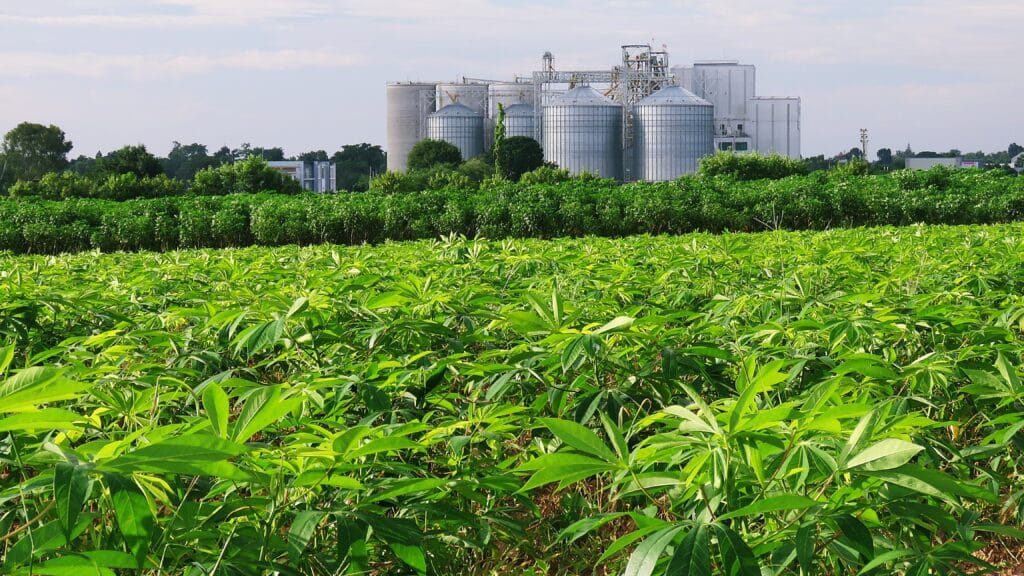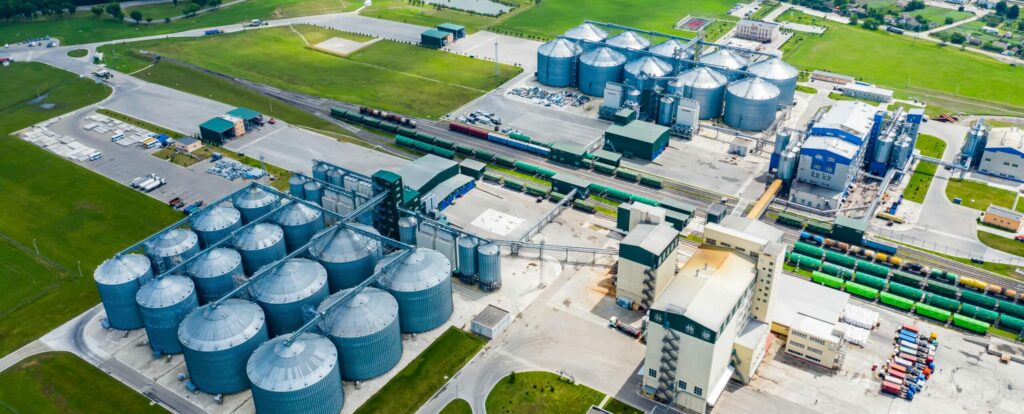
Bioethanol – also called 1G ethanol or conventional ethanol – is a biofuel from organic material, ranging from multiple grain crops, to agricultural and agro-industrial waste. This organic material is collectively known as biomass: the main feedstock used in producing bioethanol.
For comparison purposes, fossil fuels such as oil, coal and gas are the remnants of animals and plants that have been decomposing for tens of millions of years found deep in the Earth’s crust. Fossil fuels contain carbon and hydrogen, which, when burned, turn into energy.
Introducing 1G ethanol
1G ethanol offers several important advantages over traditional fossil-based fuels. First and foremost, it is renewable. Unlike fossil fuels, which are finite and will eventually be completely depleted, the agricultural and agro-industrial biomass used to produce bioethanol is renewable. This means it will continuously and virtuously take carbon from the atmosphere.
When converted into energy, bioethanol, and fossil-based fuels release a large amount of greenhouse gases. The difference of impact lies in the carbon source. Fossil-based fuels’ carbon was captured from geological sources and when burned, it releases carbon into the atmosphere, increasing the atmosphere’s CO2 concentration, and global warming. Whereas, 1G ethanol’s carbon is captured from the atmosphere, limiting the atmosphere’s concentration of CO2 increase. Thus, bioethanol’s carbon balance is improved, contributing to the reduction of climate change. Overall, improving the world’s carbon balance will help us achieve goals set out in, for example, the Paris Agreement and the EU Green Deal.
As of now, many countries rely on foreign imports for their energy needs. Such dependence can leave countries extremely vulnerable. 1G ethanol, on the other hand, supports energy independence and security. Since most countries can readily access the necessary biomass to make biofuels – or import biomass from their regular trading partners -, they are a viable solution for achieving energy independence.
From crop to fuel
Industrial 1G ethanol is produced from crops – such as corn, sugar cane, sugar beet, cassava, wheat and even rice -, agricultural residues – like corn, wheat, and sugar-cane straw -, or agro-industrial co-products not suitable for feed purposes – like heavy molasses, broken rice or bagasse. Choice of crop used to produce conventional ethanol depends largely on the originating market.
In the U.S.A., the world’s largest producer of 1G ethanol, the main feedstock is corn. Brazil, world’s 2nd leading producer, tends to primarily use sugarcane. In some European countries – France, Germany – sugar beet is the plant of choice. Many Asian markets, on their side, tend to favor corn and rice.

Before corn, sugarcane, cassava, or rice can power a car, it first needs to be converted into a fuel. Conversion starts with milling, before going through liquefaction and saccharification. Eventually, this process will lead to having the desired glucose to go through fermentation.
The diversity of yeast
It is estimated that of the 150,000 species of yeast found on Earth, only 2% have been identified. What’s more, each species has its own unique function. In the case of ethanol production, the most widely used species since antiquity has been Saccharomyces cerevisiae – Saccharo meaning “sugar” in Greek, myces meaning “fungus” and cerevisiae being derived from Latin, meaning “of beer”.
Saccharomyces cerevisiae has the unique advantage of being both highly productive and resistant to ethanol. It can also ferment a wide variety of sugars. Each strain will have complementary characteristics allowing it to perform better under specific conditions – such as very high gravity or in the presence of inhibitors. Biotech innovations allow us to couple this diversity to new characteristics. This can be done through genetic engineering, to better answer industrials’ needs (adapting to substrate variations, better performance, etc.). That is why for decades, companies like Lesaffre have been developing, selecting and then engineering industrial yeasts resistant to the specific stresses of each ethanol production process and substrate.
After fermentation, the resulting product is a binary mixture containing a 10 to 19% ethanol concentration. The next step of the ethanol refining process is the distillation of this binary mixture to reach 99.6% and 94.7%, on a weight basis, for anhydrous and hydrated fuel ethanol respectively.
After distillation & dehydration, the initial crop has been turned into ethanol, and remaining coproducts – mainly CO2 and distillers’ grains.
1G ethanol to fuel sustainable driving
When compared to all other mobility alternatives, ethanol has the highest energy efficiency combined with lower carbon footprint. And, it can be used in a wide range of compositions, from E100 to different blends with existing liquid fuels. Various blendings depend mainly on country’s specific mandates and adoption of existing technologies to enable utilization of bioethanol.
So, don’t fill up your tank quiet yet!

In the U.S., nearly 95% of all fuel used by consumer vehicles contains a blend of 10% ethanol – a.ka. E10. Furthermore, the U.S. EPA has approved E15 fuel for cars made as of 2001, which accounts for more than 96% of cars on the road.
In Europe, more and more ‘flexible fuel’ car options, which run on a combination of gasoline and up to 85% ethanol (E85), are hitting the road, while in Brazil ethanol is the rule. In Thailand, where the current blending mandate is at E10, mid- to high-level blends are available at the pump, making E20 and E85 also available country-wide.
Regardless of their differences, all these bioethanol/gasoline mixes represent an opportunity to reduce emissions and improve air quality.
Critical to the circular economy
Clearly, 1G ethanol is essential to building a biobased economy. But did you know that it is also a critical component to the circular economy?
Biobased vs. Circular economies
Biobased Economy: economic activity involving the use of biotechnology and/or biomass to produce goods, services, or energy.
Circular Economy: a model of production and consumption that involves sharing, leasing, reusing, repairing, refurbishing, and recycling existing materials and products for as long as possible to extend their lifespan and minimize waste.
Although different, the two are by no means exclusive. Both share the same goal of creating a more sustainable, resource efficient economy.
In addition to producing ethanol, the bioethanol production process also creates co-products. Co-products are naturally occurring products made during fermentation, often depicted as the pure CO2, or valuable biomolecules derived from yeast cells that enrich feed streams like distilled grains.
During the production of 1G ethanol, yeast releases CO2 during fermentation. But, instead of letting that CO2 go into the atmosphere – as is the case when fossil fuels are burned – it can be captured and reused in, carbonated beverages or for cold storage logistics.
As for the distillers grain, this mashup of non-fermented components and yeast left after distillation can be reused as a high-protein ingredient in livestock feed. That feed is then fed to animals, producing food for human consumption and manure. That manure can later be further reused as a biomass for producing biogas.
From agricultural biomass to fuel, food and feed, 1G ethanol promotes a circular economy!
Driving the global development of sustainable 1G ethanol
1G ethanol is an essential piece for our sustainable future. As such, bioethanol producers will require continuous innovation, disruptive technologies to support net-zero, and high-performance products and services.








